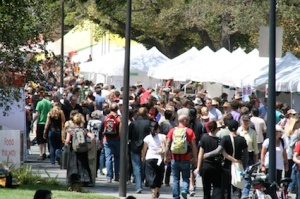For our final instalment in the Conserve Delhi 2010 ideas hub I’d like to share a response from Riki Edelsten, Partnership and Resources Manager at one of Melbourne’s premier community events: the Sustainable Living Festival.

Sustainable Living Festival crowds along the Yarra River
Over the past decade the Sustainable Living Festival has inspired large audiences to live more sustainably, by showcasing and celebrating sustainability in the heart of Melbourne city.
Much has changed since the first Festival in 1998, held in regional Victoria and attended by just over 2,000 devoted innovators: the Festival now attracts over 120,000 visits to the event in Federation Square each February.
In 2011 the Festival is expanding to meet people where they’re at. Inspired by successful community engagement and mobilisation models from around the world, the 2011 Festival two week extended format is reaching out into our streets and suburbs engaging new audiences on local and global issues and relevant solutions.
This will be the fifth year I have been involved with the Festival. I began as a volunteer in 2006, producing Festival communication materials. Then I went on to find employment with a major sponsor of the Festival, the Victorian Government’s lead agency on Climate Change, Sustainability Victoria. This year I’ve returned as part of the Festival core team and I’m loving it!
2011 Sustainable Living Festival website: http://festival.slf.org.au/
1. What’s the motivation behind the Sustainable Living Festival?
The ongoing goal of the Sustainable Living Festival is to accelerate community uptake of sustainability. Therefore we were delighted that 90% of visitors to the Festival believed that information from the 2010 Festival will help them to take action to live more sustainably.
2. How do you deliver the Festival with minimal environmental impact?
The Festival aims to walk the talk in event production. Each Festival our team work hard to deliver an event following our ‘Own Practice’ principles:
Cyclic – creating no waste
Solar – using clean energy
Efficient – running with less
Safe – ensuring its harmless
Social – caring for people
Smart – adapting to change
Some of the ways we deliver on these principles are:
- The Festival uses 100% accredited GreenPower.
- Promotional materials are printed using a waterless printing process, vegetable based inks and forest-friendly paper stocks or recycled waste paper.
- Throughout the Festival a well-signed, four-bin system encourages attendees to separate paper, glass, cans, plastic, and food waste for compost and recycling. A waste wise ‘menu’ is also available at tables in the café area, informing patrons about our system and how they can use it.
- Another great sustainability workout for our volunteers is the Wash Against Waste (WAW) stand. At WAW, a team of volunteers washes and dries used plates and cutlery from Festival food venders, thereby eliminating the need for disposable food and beverage containers. So popular is this concept that the Sustainable Living Foundation developed a WAW service to deliver to other festivals around the Victoria.
For more on the Festival’s own practice principles check out our website.
3. What are the main challenges you’ve overcome?
The main challenges are staging a Festival through a team that is made up of primarily volunteers. With a limited budget, employment periods are short which makes forward planning near impossible.
4. What are the main types of waste created at the SLF festival and what’s the most unusual waste stream you’ve had to deal with?
Probably not highly unusual, but definitely an unexpected waste stream, were plastis cups supplied by one of our partner organizations in 2009, accounting for the sharp rise in rubbish to landfill.

Sustainable Living Festival waste management statistics
5. Have you ever heard of upcycling being done with waste after an event like the Commonwealth Games? If not, how do you think it can be best included in major event production and management?
No, I’ve never heard of waste from an event being upcycled. The best way to include it into an on-going event is with a sales or marketing edge, illustrating a point of difference to event patrons. Imagine if waste from an event was made into products that were sold at the next event – like promotional, branded reuseable cups/bags/water bottles – then the upcycling tells a story event patrons feel a part of. The upcycled promotional products become the outfits of a subculture.
6. What kind of upcycled products would you make from major event waste?
Festival belts with pouches to carry your essential festival kit, water bottles, crockery and cutlery. Items that can be used at the event.
Tags: conserve delhi 2010, Federation Square, Melbourne, plastic waste, recycling, SLF own practice principles, sustainability victoria, Sustainable Living Festival, upcycled products, upcycling, waste wise























